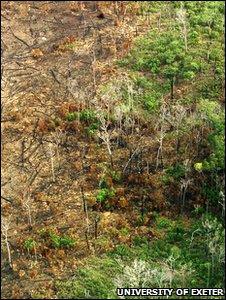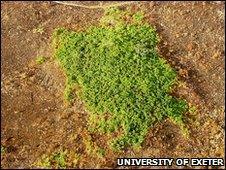Amazon forest fires 'on the rise'
- Published

"Fire leaks" from nearby land is a common cause for forest fires
The number of fires destroying Amazon rainforests are increasing, a study has found.
A team of scientists said fires in the region could release similar amounts of carbon as deliberate deforestation.
Writing in Science, they said fire occurrence rates had increased in 59% of areas with reduced deforestation.
As a result, the rise in fires could jeopardise the long-term success of schemes to reduce emissions from deforestation, they added.
The researchers - from the University of Exeter, UK, and Brazil's National Institute for Space Research - based their findings on satellite-derived data on deforestation and forest fires.
"The results were a surprise because we expected that fires would have decreased with the decrease of deforestation," said co-author Luiz Aragao from the University of Exeter.
"The implication for REDD is that we first need a system that can monitor fires," he told the Science journal.
"There is also a need to shift land use in the Amazon to a system where fire is not used."
'Slash and burn'
REDD (Reducing Emissions from Deforestation and forest Degradation) schemes aim to create a financil value for the carbon stored in developing nations' tropical forests.
It offers nations incentives to protect forest areas from a variety of impacts that release carbon into the atmosphere, including tree felling and logging, agricultural expansion, land degradation.
As deforestation accounts for about 20% of emissions resulting from human activity, the REDD programmes are considered to be a key component in the global effort to curb climate change.
"Fires following drought years are likely to release a similar amount of carbon as emissions from deliberate deforestation," the researchers wrote.
"The higher probability of a drier Amazon in the 21st Century predicted by some global circulation models... may push Amazonia towards an amplified fire-prone system."
They added that previous studies showed that fires in the region increased after large-scale droughts in 1998 and 2005.
"Forest landscapes in Amazonia are becoming more fragmented and, therefore, a growing proportion of forests is exposed to the leakage of accidental fires from adjacent farms," they suggested.
The practice of "slash and burn" is widely used by farmers in the Amazon region to clear secondary forests and allow food and cash crops to be cultivated.

Fragmentation increases the amount of forest edges at risk of being set alight
But Dr Aragao said: "We need to change the way people use and manage their land so that they can do this without fire."
Commenting on the paper's findings, Andrew Mitchell, director of the Global Canopy Programme, said: "These results have important implications for REDD negotiations.
"If we are to control deforestation, you have got to look at what local people are doing outside of the forests," he told BBC News.
"The entire REDD regime need to encourage a better use of land without fire.
"But if they do not use fire, which is cheap, then what are they going to use - strimmers? Chainsaws? Tractors?
"That means that money from REDD programmes need to go to people that not only live within the forests, but also the farmers living outside them."
Dr Aragao agreed, adding that switching to fire-free land management in already deforested area that lie next to forests could "drastically reduce fires and carbon emissions".
"It would be expensive," he observed, "but it would protect the stability of Amazonian carbon stocks and diversity."
Pieter van Lierop, a forestry officer for the Food and Agriculture Organization (FA) - a member of the UN's REDD programme, said the findings were relevant to policies aimed at reducing deforestation.
"The article clearly demonstrates that within REDD, specific attention should go to analyzing the role of fire and propose more responsible use of fire and/or alternatives for fire," he told BBC News.
"However, we should also take into consideration that the article is mainly discussing fire incidence and occurence, meaning number of fires and not the size of emissions."